Dental Education Requirements: Skills, Procedures, and Challenges
VerifiedAdded on 2023/04/04
|13
|4292
|256
Report
AI Summary
This report provides a comprehensive analysis of dental education requirements, emphasizing the importance of dental education for various groups including children, common people, patients, dentists, and dental students. It explores different methods of dental education, such as communication media, adequate training, hands-on clinical practice, and assessments, and delves into competency-based education and its framework. The report also identifies necessary skills for dental practitioners, including intellectual, kinesthetic, decision-making, technological, and professional integrity, and discusses common procedures practiced by dental professionals. Furthermore, it addresses the issues faced by learners, challenges in the profession, and analyzes the gap between expected and real outcomes, suggesting areas for improvement and highlighting the standards of dental education. The document emphasizes the need for continuous evaluation and adaptation to meet the evolving demands of dental practice.
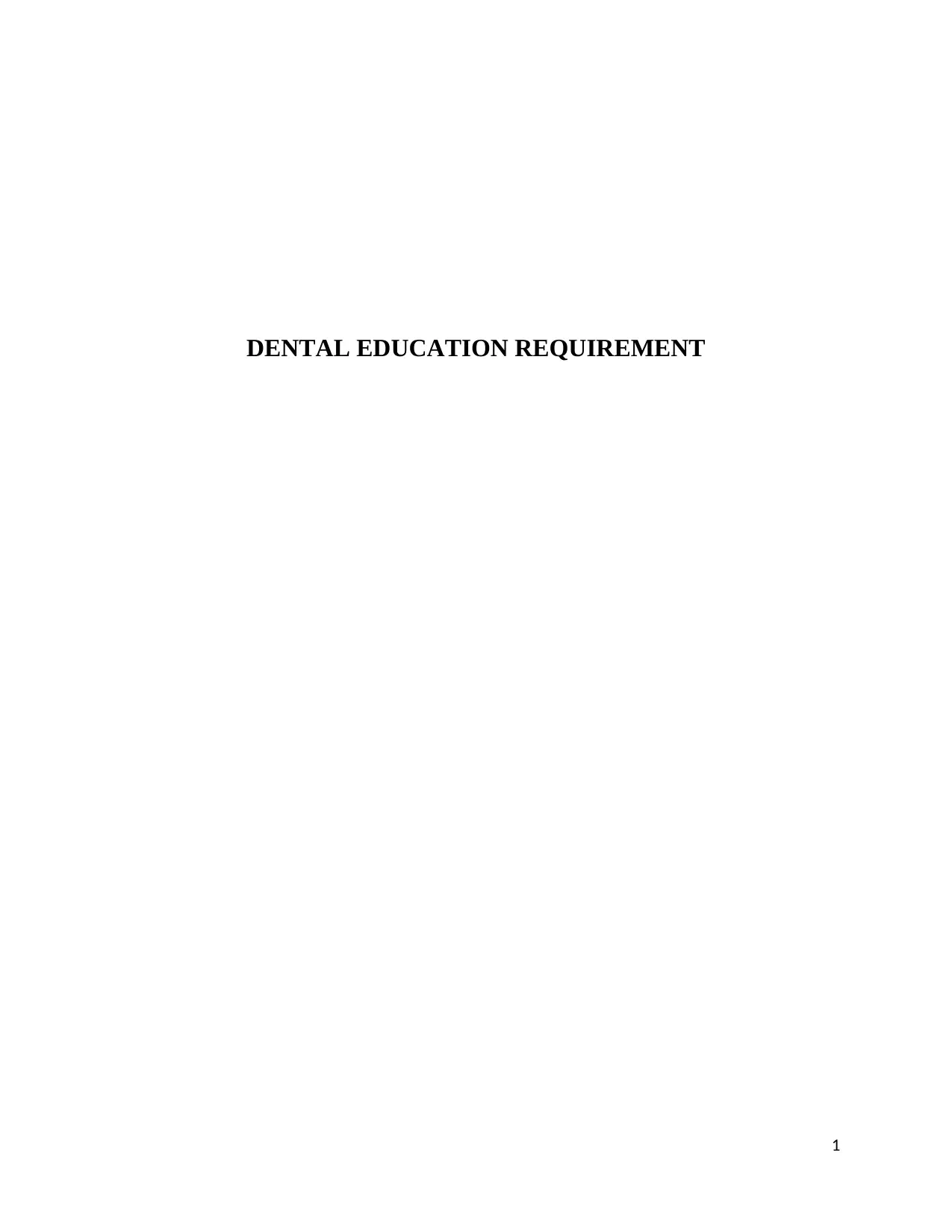
DENTAL EDUCATION REQUIREMENT
1
1
Paraphrase This Document
Need a fresh take? Get an instant paraphrase of this document with our AI Paraphraser
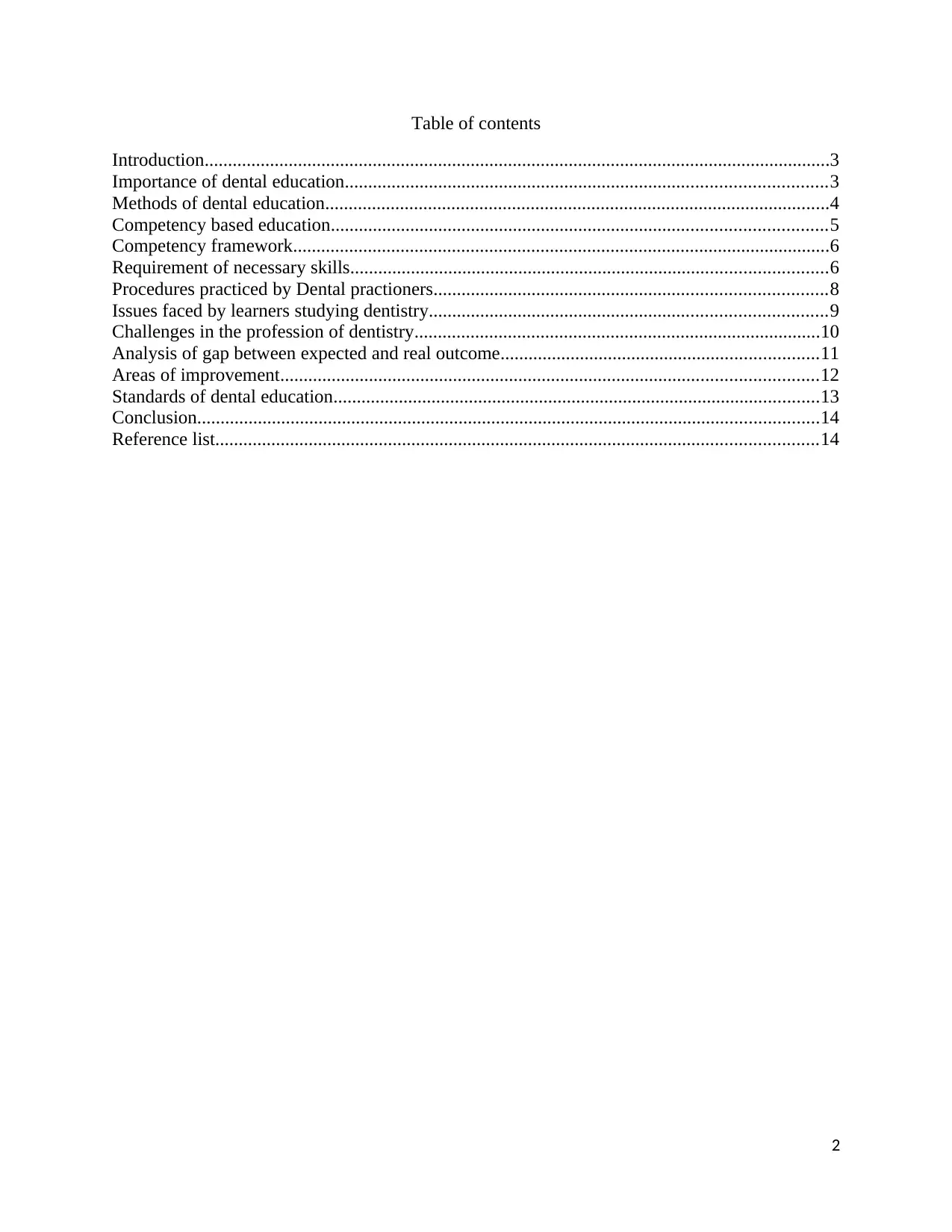
Table of contents
Introduction......................................................................................................................................3
Importance of dental education.......................................................................................................3
Methods of dental education............................................................................................................4
Competency based education..........................................................................................................5
Competency framework...................................................................................................................6
Requirement of necessary skills......................................................................................................6
Procedures practiced by Dental practioners....................................................................................8
Issues faced by learners studying dentistry.....................................................................................9
Challenges in the profession of dentistry.......................................................................................10
Analysis of gap between expected and real outcome....................................................................11
Areas of improvement...................................................................................................................12
Standards of dental education........................................................................................................13
Conclusion.....................................................................................................................................14
Reference list.................................................................................................................................14
2
Introduction......................................................................................................................................3
Importance of dental education.......................................................................................................3
Methods of dental education............................................................................................................4
Competency based education..........................................................................................................5
Competency framework...................................................................................................................6
Requirement of necessary skills......................................................................................................6
Procedures practiced by Dental practioners....................................................................................8
Issues faced by learners studying dentistry.....................................................................................9
Challenges in the profession of dentistry.......................................................................................10
Analysis of gap between expected and real outcome....................................................................11
Areas of improvement...................................................................................................................12
Standards of dental education........................................................................................................13
Conclusion.....................................................................................................................................14
Reference list.................................................................................................................................14
2
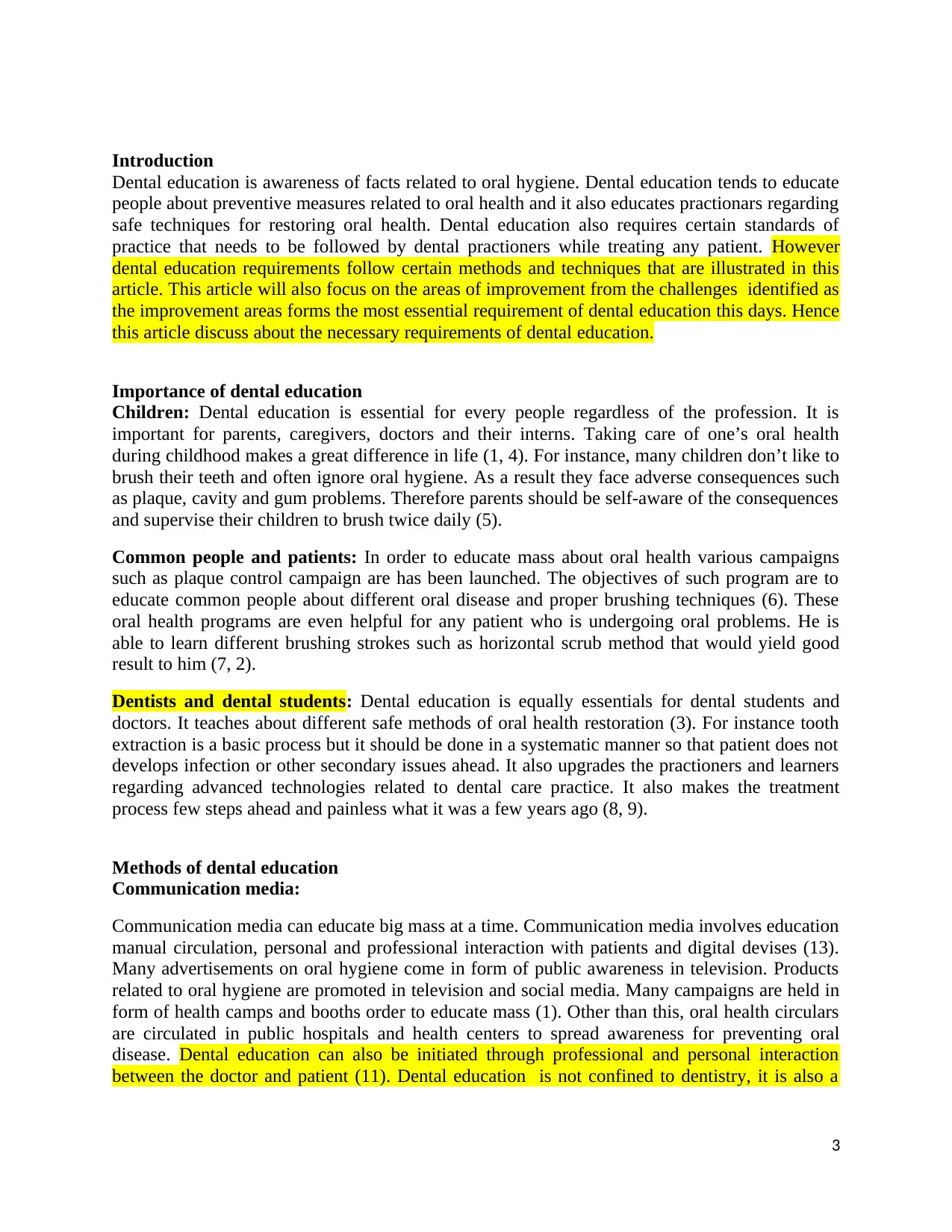
Introduction
Dental education is awareness of facts related to oral hygiene. Dental education tends to educate
people about preventive measures related to oral health and it also educates practionars regarding
safe techniques for restoring oral health. Dental education also requires certain standards of
practice that needs to be followed by dental practioners while treating any patient. However
dental education requirements follow certain methods and techniques that are illustrated in this
article. This article will also focus on the areas of improvement from the challenges identified as
the improvement areas forms the most essential requirement of dental education this days. Hence
this article discuss about the necessary requirements of dental education.
Importance of dental education
Children: Dental education is essential for every people regardless of the profession. It is
important for parents, caregivers, doctors and their interns. Taking care of one’s oral health
during childhood makes a great difference in life (1, 4). For instance, many children don’t like to
brush their teeth and often ignore oral hygiene. As a result they face adverse consequences such
as plaque, cavity and gum problems. Therefore parents should be self-aware of the consequences
and supervise their children to brush twice daily (5).
Common people and patients: In order to educate mass about oral health various campaigns
such as plaque control campaign are has been launched. The objectives of such program are to
educate common people about different oral disease and proper brushing techniques (6). These
oral health programs are even helpful for any patient who is undergoing oral problems. He is
able to learn different brushing strokes such as horizontal scrub method that would yield good
result to him (7, 2).
Dentists and dental students: Dental education is equally essentials for dental students and
doctors. It teaches about different safe methods of oral health restoration (3). For instance tooth
extraction is a basic process but it should be done in a systematic manner so that patient does not
develops infection or other secondary issues ahead. It also upgrades the practioners and learners
regarding advanced technologies related to dental care practice. It also makes the treatment
process few steps ahead and painless what it was a few years ago (8, 9).
Methods of dental education
Communication media:
Communication media can educate big mass at a time. Communication media involves education
manual circulation, personal and professional interaction with patients and digital devises (13).
Many advertisements on oral hygiene come in form of public awareness in television. Products
related to oral hygiene are promoted in television and social media. Many campaigns are held in
form of health camps and booths order to educate mass (1). Other than this, oral health circulars
are circulated in public hospitals and health centers to spread awareness for preventing oral
disease. Dental education can also be initiated through professional and personal interaction
between the doctor and patient (11). Dental education is not confined to dentistry, it is also a
3
Dental education is awareness of facts related to oral hygiene. Dental education tends to educate
people about preventive measures related to oral health and it also educates practionars regarding
safe techniques for restoring oral health. Dental education also requires certain standards of
practice that needs to be followed by dental practioners while treating any patient. However
dental education requirements follow certain methods and techniques that are illustrated in this
article. This article will also focus on the areas of improvement from the challenges identified as
the improvement areas forms the most essential requirement of dental education this days. Hence
this article discuss about the necessary requirements of dental education.
Importance of dental education
Children: Dental education is essential for every people regardless of the profession. It is
important for parents, caregivers, doctors and their interns. Taking care of one’s oral health
during childhood makes a great difference in life (1, 4). For instance, many children don’t like to
brush their teeth and often ignore oral hygiene. As a result they face adverse consequences such
as plaque, cavity and gum problems. Therefore parents should be self-aware of the consequences
and supervise their children to brush twice daily (5).
Common people and patients: In order to educate mass about oral health various campaigns
such as plaque control campaign are has been launched. The objectives of such program are to
educate common people about different oral disease and proper brushing techniques (6). These
oral health programs are even helpful for any patient who is undergoing oral problems. He is
able to learn different brushing strokes such as horizontal scrub method that would yield good
result to him (7, 2).
Dentists and dental students: Dental education is equally essentials for dental students and
doctors. It teaches about different safe methods of oral health restoration (3). For instance tooth
extraction is a basic process but it should be done in a systematic manner so that patient does not
develops infection or other secondary issues ahead. It also upgrades the practioners and learners
regarding advanced technologies related to dental care practice. It also makes the treatment
process few steps ahead and painless what it was a few years ago (8, 9).
Methods of dental education
Communication media:
Communication media can educate big mass at a time. Communication media involves education
manual circulation, personal and professional interaction with patients and digital devises (13).
Many advertisements on oral hygiene come in form of public awareness in television. Products
related to oral hygiene are promoted in television and social media. Many campaigns are held in
form of health camps and booths order to educate mass (1). Other than this, oral health circulars
are circulated in public hospitals and health centers to spread awareness for preventing oral
disease. Dental education can also be initiated through professional and personal interaction
between the doctor and patient (11). Dental education is not confined to dentistry, it is also a
3
⊘ This is a preview!⊘
Do you want full access?
Subscribe today to unlock all pages.

Trusted by 1+ million students worldwide
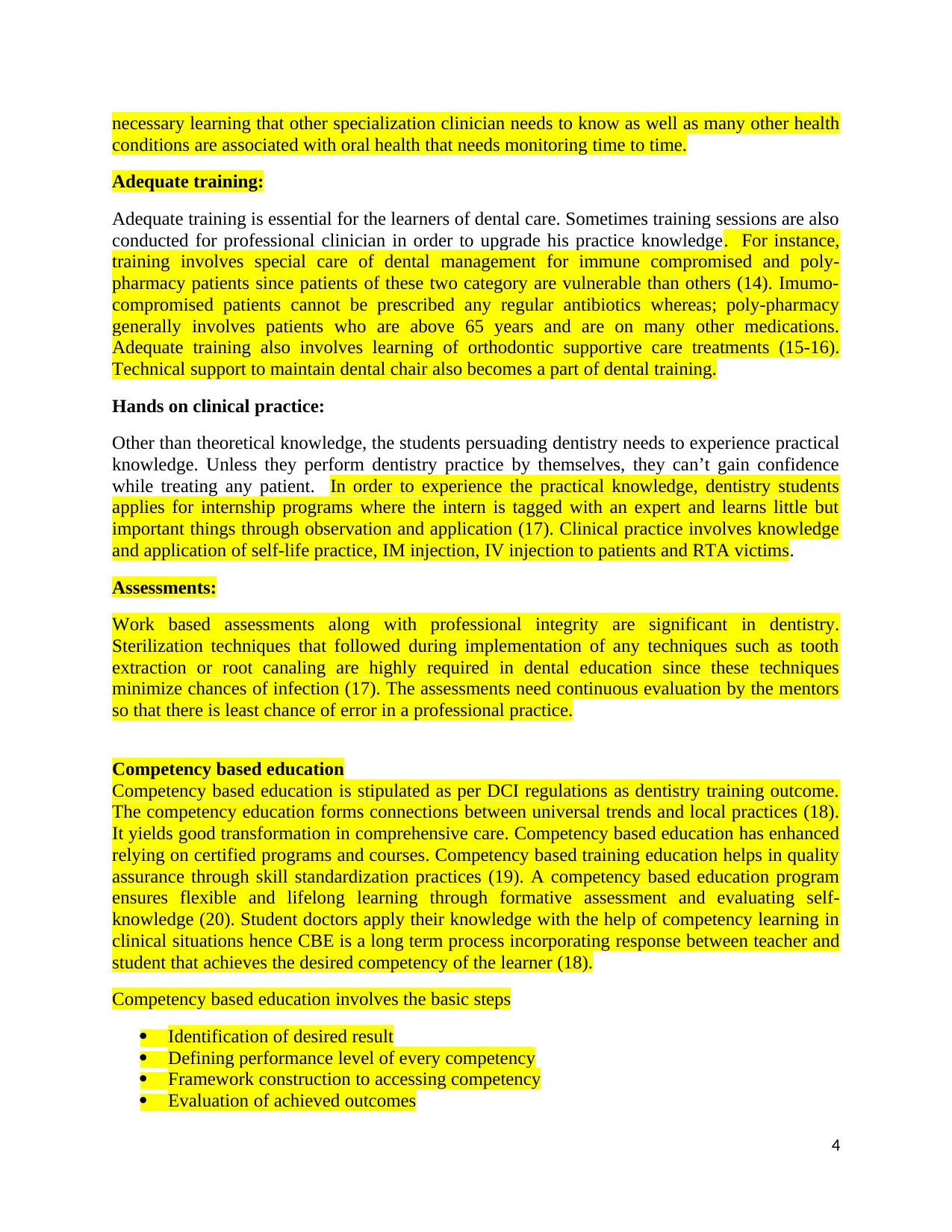
necessary learning that other specialization clinician needs to know as well as many other health
conditions are associated with oral health that needs monitoring time to time.
Adequate training:
Adequate training is essential for the learners of dental care. Sometimes training sessions are also
conducted for professional clinician in order to upgrade his practice knowledge. For instance,
training involves special care of dental management for immune compromised and poly-
pharmacy patients since patients of these two category are vulnerable than others (14). Imumo-
compromised patients cannot be prescribed any regular antibiotics whereas; poly-pharmacy
generally involves patients who are above 65 years and are on many other medications.
Adequate training also involves learning of orthodontic supportive care treatments (15-16).
Technical support to maintain dental chair also becomes a part of dental training.
Hands on clinical practice:
Other than theoretical knowledge, the students persuading dentistry needs to experience practical
knowledge. Unless they perform dentistry practice by themselves, they can’t gain confidence
while treating any patient. In order to experience the practical knowledge, dentistry students
applies for internship programs where the intern is tagged with an expert and learns little but
important things through observation and application (17). Clinical practice involves knowledge
and application of self-life practice, IM injection, IV injection to patients and RTA victims.
Assessments:
Work based assessments along with professional integrity are significant in dentistry.
Sterilization techniques that followed during implementation of any techniques such as tooth
extraction or root canaling are highly required in dental education since these techniques
minimize chances of infection (17). The assessments need continuous evaluation by the mentors
so that there is least chance of error in a professional practice.
Competency based education
Competency based education is stipulated as per DCI regulations as dentistry training outcome.
The competency education forms connections between universal trends and local practices (18).
It yields good transformation in comprehensive care. Competency based education has enhanced
relying on certified programs and courses. Competency based training education helps in quality
assurance through skill standardization practices (19). A competency based education program
ensures flexible and lifelong learning through formative assessment and evaluating self-
knowledge (20). Student doctors apply their knowledge with the help of competency learning in
clinical situations hence CBE is a long term process incorporating response between teacher and
student that achieves the desired competency of the learner (18).
Competency based education involves the basic steps
Identification of desired result
Defining performance level of every competency
Framework construction to accessing competency
Evaluation of achieved outcomes
4
conditions are associated with oral health that needs monitoring time to time.
Adequate training:
Adequate training is essential for the learners of dental care. Sometimes training sessions are also
conducted for professional clinician in order to upgrade his practice knowledge. For instance,
training involves special care of dental management for immune compromised and poly-
pharmacy patients since patients of these two category are vulnerable than others (14). Imumo-
compromised patients cannot be prescribed any regular antibiotics whereas; poly-pharmacy
generally involves patients who are above 65 years and are on many other medications.
Adequate training also involves learning of orthodontic supportive care treatments (15-16).
Technical support to maintain dental chair also becomes a part of dental training.
Hands on clinical practice:
Other than theoretical knowledge, the students persuading dentistry needs to experience practical
knowledge. Unless they perform dentistry practice by themselves, they can’t gain confidence
while treating any patient. In order to experience the practical knowledge, dentistry students
applies for internship programs where the intern is tagged with an expert and learns little but
important things through observation and application (17). Clinical practice involves knowledge
and application of self-life practice, IM injection, IV injection to patients and RTA victims.
Assessments:
Work based assessments along with professional integrity are significant in dentistry.
Sterilization techniques that followed during implementation of any techniques such as tooth
extraction or root canaling are highly required in dental education since these techniques
minimize chances of infection (17). The assessments need continuous evaluation by the mentors
so that there is least chance of error in a professional practice.
Competency based education
Competency based education is stipulated as per DCI regulations as dentistry training outcome.
The competency education forms connections between universal trends and local practices (18).
It yields good transformation in comprehensive care. Competency based education has enhanced
relying on certified programs and courses. Competency based training education helps in quality
assurance through skill standardization practices (19). A competency based education program
ensures flexible and lifelong learning through formative assessment and evaluating self-
knowledge (20). Student doctors apply their knowledge with the help of competency learning in
clinical situations hence CBE is a long term process incorporating response between teacher and
student that achieves the desired competency of the learner (18).
Competency based education involves the basic steps
Identification of desired result
Defining performance level of every competency
Framework construction to accessing competency
Evaluation of achieved outcomes
4
Paraphrase This Document
Need a fresh take? Get an instant paraphrase of this document with our AI Paraphraser
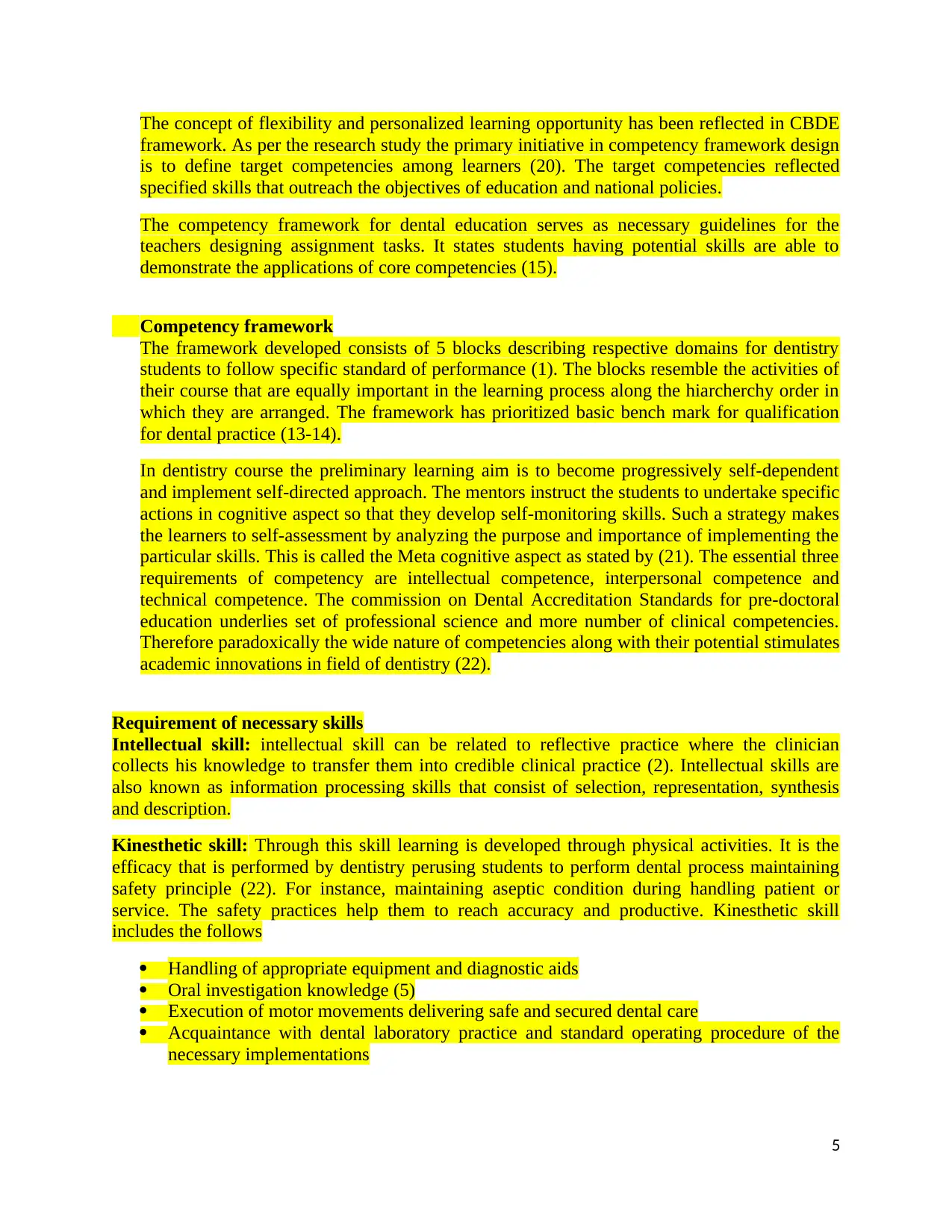
The concept of flexibility and personalized learning opportunity has been reflected in CBDE
framework. As per the research study the primary initiative in competency framework design
is to define target competencies among learners (20). The target competencies reflected
specified skills that outreach the objectives of education and national policies.
The competency framework for dental education serves as necessary guidelines for the
teachers designing assignment tasks. It states students having potential skills are able to
demonstrate the applications of core competencies (15).
Competency framework
The framework developed consists of 5 blocks describing respective domains for dentistry
students to follow specific standard of performance (1). The blocks resemble the activities of
their course that are equally important in the learning process along the hiarcherchy order in
which they are arranged. The framework has prioritized basic bench mark for qualification
for dental practice (13-14).
In dentistry course the preliminary learning aim is to become progressively self-dependent
and implement self-directed approach. The mentors instruct the students to undertake specific
actions in cognitive aspect so that they develop self-monitoring skills. Such a strategy makes
the learners to self-assessment by analyzing the purpose and importance of implementing the
particular skills. This is called the Meta cognitive aspect as stated by (21). The essential three
requirements of competency are intellectual competence, interpersonal competence and
technical competence. The commission on Dental Accreditation Standards for pre-doctoral
education underlies set of professional science and more number of clinical competencies.
Therefore paradoxically the wide nature of competencies along with their potential stimulates
academic innovations in field of dentistry (22).
Requirement of necessary skills
Intellectual skill: intellectual skill can be related to reflective practice where the clinician
collects his knowledge to transfer them into credible clinical practice (2). Intellectual skills are
also known as information processing skills that consist of selection, representation, synthesis
and description.
Kinesthetic skill: Through this skill learning is developed through physical activities. It is the
efficacy that is performed by dentistry perusing students to perform dental process maintaining
safety principle (22). For instance, maintaining aseptic condition during handling patient or
service. The safety practices help them to reach accuracy and productive. Kinesthetic skill
includes the follows
Handling of appropriate equipment and diagnostic aids
Oral investigation knowledge (5)
Execution of motor movements delivering safe and secured dental care
Acquaintance with dental laboratory practice and standard operating procedure of the
necessary implementations
5
framework. As per the research study the primary initiative in competency framework design
is to define target competencies among learners (20). The target competencies reflected
specified skills that outreach the objectives of education and national policies.
The competency framework for dental education serves as necessary guidelines for the
teachers designing assignment tasks. It states students having potential skills are able to
demonstrate the applications of core competencies (15).
Competency framework
The framework developed consists of 5 blocks describing respective domains for dentistry
students to follow specific standard of performance (1). The blocks resemble the activities of
their course that are equally important in the learning process along the hiarcherchy order in
which they are arranged. The framework has prioritized basic bench mark for qualification
for dental practice (13-14).
In dentistry course the preliminary learning aim is to become progressively self-dependent
and implement self-directed approach. The mentors instruct the students to undertake specific
actions in cognitive aspect so that they develop self-monitoring skills. Such a strategy makes
the learners to self-assessment by analyzing the purpose and importance of implementing the
particular skills. This is called the Meta cognitive aspect as stated by (21). The essential three
requirements of competency are intellectual competence, interpersonal competence and
technical competence. The commission on Dental Accreditation Standards for pre-doctoral
education underlies set of professional science and more number of clinical competencies.
Therefore paradoxically the wide nature of competencies along with their potential stimulates
academic innovations in field of dentistry (22).
Requirement of necessary skills
Intellectual skill: intellectual skill can be related to reflective practice where the clinician
collects his knowledge to transfer them into credible clinical practice (2). Intellectual skills are
also known as information processing skills that consist of selection, representation, synthesis
and description.
Kinesthetic skill: Through this skill learning is developed through physical activities. It is the
efficacy that is performed by dentistry perusing students to perform dental process maintaining
safety principle (22). For instance, maintaining aseptic condition during handling patient or
service. The safety practices help them to reach accuracy and productive. Kinesthetic skill
includes the follows
Handling of appropriate equipment and diagnostic aids
Oral investigation knowledge (5)
Execution of motor movements delivering safe and secured dental care
Acquaintance with dental laboratory practice and standard operating procedure of the
necessary implementations
5
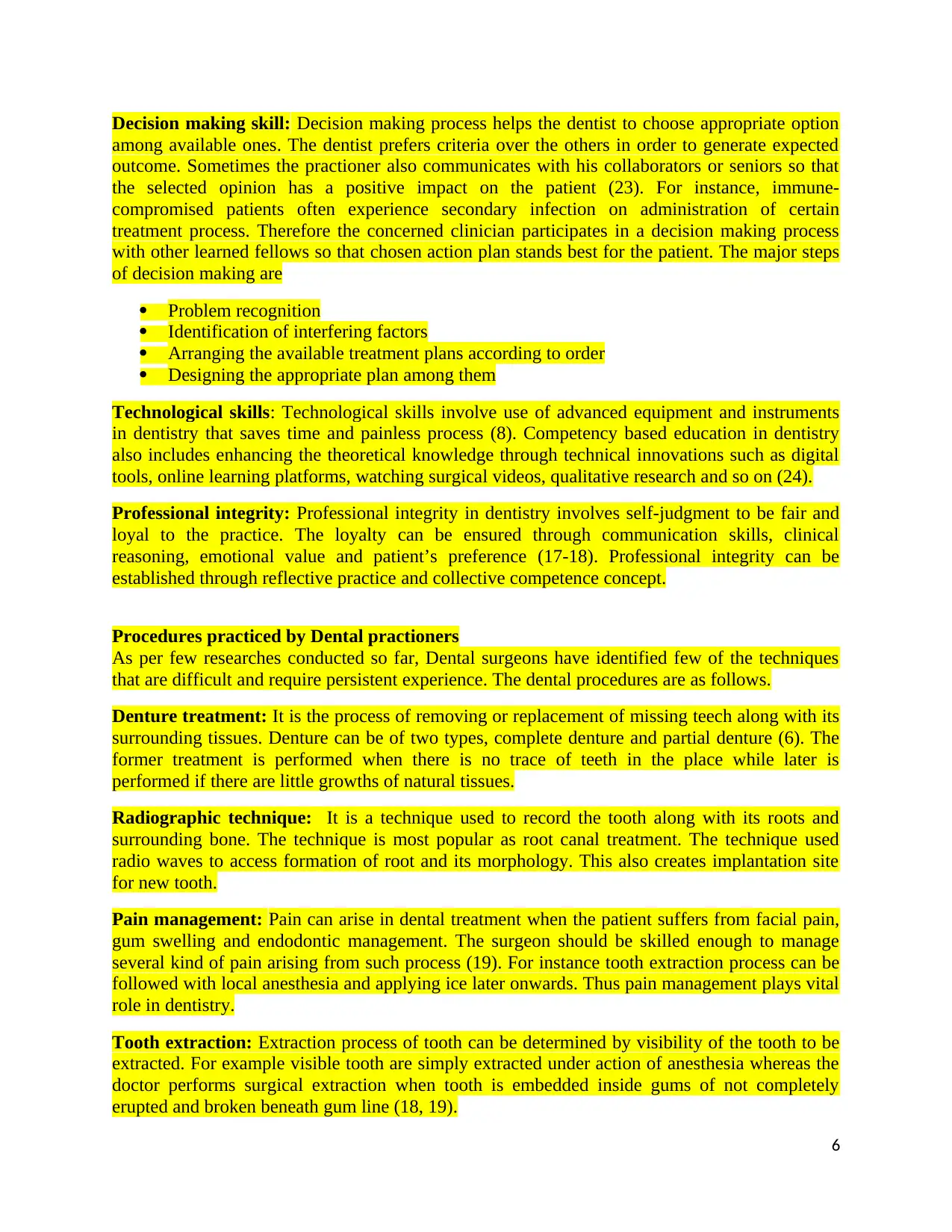
Decision making skill: Decision making process helps the dentist to choose appropriate option
among available ones. The dentist prefers criteria over the others in order to generate expected
outcome. Sometimes the practioner also communicates with his collaborators or seniors so that
the selected opinion has a positive impact on the patient (23). For instance, immune-
compromised patients often experience secondary infection on administration of certain
treatment process. Therefore the concerned clinician participates in a decision making process
with other learned fellows so that chosen action plan stands best for the patient. The major steps
of decision making are
Problem recognition
Identification of interfering factors
Arranging the available treatment plans according to order
Designing the appropriate plan among them
Technological skills: Technological skills involve use of advanced equipment and instruments
in dentistry that saves time and painless process (8). Competency based education in dentistry
also includes enhancing the theoretical knowledge through technical innovations such as digital
tools, online learning platforms, watching surgical videos, qualitative research and so on (24).
Professional integrity: Professional integrity in dentistry involves self-judgment to be fair and
loyal to the practice. The loyalty can be ensured through communication skills, clinical
reasoning, emotional value and patient’s preference (17-18). Professional integrity can be
established through reflective practice and collective competence concept.
Procedures practiced by Dental practioners
As per few researches conducted so far, Dental surgeons have identified few of the techniques
that are difficult and require persistent experience. The dental procedures are as follows.
Denture treatment: It is the process of removing or replacement of missing teech along with its
surrounding tissues. Denture can be of two types, complete denture and partial denture (6). The
former treatment is performed when there is no trace of teeth in the place while later is
performed if there are little growths of natural tissues.
Radiographic technique: It is a technique used to record the tooth along with its roots and
surrounding bone. The technique is most popular as root canal treatment. The technique used
radio waves to access formation of root and its morphology. This also creates implantation site
for new tooth.
Pain management: Pain can arise in dental treatment when the patient suffers from facial pain,
gum swelling and endodontic management. The surgeon should be skilled enough to manage
several kind of pain arising from such process (19). For instance tooth extraction process can be
followed with local anesthesia and applying ice later onwards. Thus pain management plays vital
role in dentistry.
Tooth extraction: Extraction process of tooth can be determined by visibility of the tooth to be
extracted. For example visible tooth are simply extracted under action of anesthesia whereas the
doctor performs surgical extraction when tooth is embedded inside gums of not completely
erupted and broken beneath gum line (18, 19).
6
among available ones. The dentist prefers criteria over the others in order to generate expected
outcome. Sometimes the practioner also communicates with his collaborators or seniors so that
the selected opinion has a positive impact on the patient (23). For instance, immune-
compromised patients often experience secondary infection on administration of certain
treatment process. Therefore the concerned clinician participates in a decision making process
with other learned fellows so that chosen action plan stands best for the patient. The major steps
of decision making are
Problem recognition
Identification of interfering factors
Arranging the available treatment plans according to order
Designing the appropriate plan among them
Technological skills: Technological skills involve use of advanced equipment and instruments
in dentistry that saves time and painless process (8). Competency based education in dentistry
also includes enhancing the theoretical knowledge through technical innovations such as digital
tools, online learning platforms, watching surgical videos, qualitative research and so on (24).
Professional integrity: Professional integrity in dentistry involves self-judgment to be fair and
loyal to the practice. The loyalty can be ensured through communication skills, clinical
reasoning, emotional value and patient’s preference (17-18). Professional integrity can be
established through reflective practice and collective competence concept.
Procedures practiced by Dental practioners
As per few researches conducted so far, Dental surgeons have identified few of the techniques
that are difficult and require persistent experience. The dental procedures are as follows.
Denture treatment: It is the process of removing or replacement of missing teech along with its
surrounding tissues. Denture can be of two types, complete denture and partial denture (6). The
former treatment is performed when there is no trace of teeth in the place while later is
performed if there are little growths of natural tissues.
Radiographic technique: It is a technique used to record the tooth along with its roots and
surrounding bone. The technique is most popular as root canal treatment. The technique used
radio waves to access formation of root and its morphology. This also creates implantation site
for new tooth.
Pain management: Pain can arise in dental treatment when the patient suffers from facial pain,
gum swelling and endodontic management. The surgeon should be skilled enough to manage
several kind of pain arising from such process (19). For instance tooth extraction process can be
followed with local anesthesia and applying ice later onwards. Thus pain management plays vital
role in dentistry.
Tooth extraction: Extraction process of tooth can be determined by visibility of the tooth to be
extracted. For example visible tooth are simply extracted under action of anesthesia whereas the
doctor performs surgical extraction when tooth is embedded inside gums of not completely
erupted and broken beneath gum line (18, 19).
6
⊘ This is a preview!⊘
Do you want full access?
Subscribe today to unlock all pages.

Trusted by 1+ million students worldwide
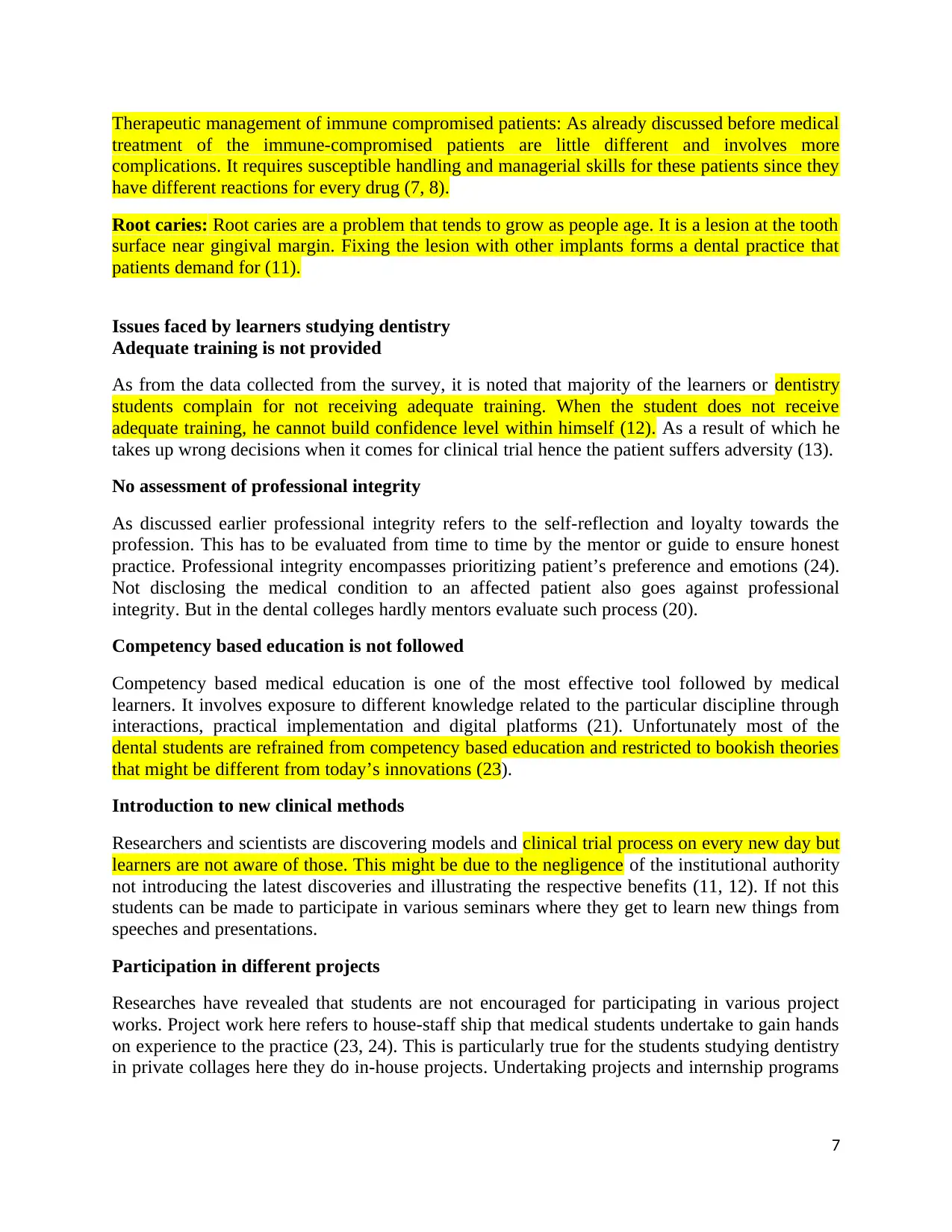
Therapeutic management of immune compromised patients: As already discussed before medical
treatment of the immune-compromised patients are little different and involves more
complications. It requires susceptible handling and managerial skills for these patients since they
have different reactions for every drug (7, 8).
Root caries: Root caries are a problem that tends to grow as people age. It is a lesion at the tooth
surface near gingival margin. Fixing the lesion with other implants forms a dental practice that
patients demand for (11).
Issues faced by learners studying dentistry
Adequate training is not provided
As from the data collected from the survey, it is noted that majority of the learners or dentistry
students complain for not receiving adequate training. When the student does not receive
adequate training, he cannot build confidence level within himself (12). As a result of which he
takes up wrong decisions when it comes for clinical trial hence the patient suffers adversity (13).
No assessment of professional integrity
As discussed earlier professional integrity refers to the self-reflection and loyalty towards the
profession. This has to be evaluated from time to time by the mentor or guide to ensure honest
practice. Professional integrity encompasses prioritizing patient’s preference and emotions (24).
Not disclosing the medical condition to an affected patient also goes against professional
integrity. But in the dental colleges hardly mentors evaluate such process (20).
Competency based education is not followed
Competency based medical education is one of the most effective tool followed by medical
learners. It involves exposure to different knowledge related to the particular discipline through
interactions, practical implementation and digital platforms (21). Unfortunately most of the
dental students are refrained from competency based education and restricted to bookish theories
that might be different from today’s innovations (23).
Introduction to new clinical methods
Researchers and scientists are discovering models and clinical trial process on every new day but
learners are not aware of those. This might be due to the negligence of the institutional authority
not introducing the latest discoveries and illustrating the respective benefits (11, 12). If not this
students can be made to participate in various seminars where they get to learn new things from
speeches and presentations.
Participation in different projects
Researches have revealed that students are not encouraged for participating in various project
works. Project work here refers to house-staff ship that medical students undertake to gain hands
on experience to the practice (23, 24). This is particularly true for the students studying dentistry
in private collages here they do in-house projects. Undertaking projects and internship programs
7
treatment of the immune-compromised patients are little different and involves more
complications. It requires susceptible handling and managerial skills for these patients since they
have different reactions for every drug (7, 8).
Root caries: Root caries are a problem that tends to grow as people age. It is a lesion at the tooth
surface near gingival margin. Fixing the lesion with other implants forms a dental practice that
patients demand for (11).
Issues faced by learners studying dentistry
Adequate training is not provided
As from the data collected from the survey, it is noted that majority of the learners or dentistry
students complain for not receiving adequate training. When the student does not receive
adequate training, he cannot build confidence level within himself (12). As a result of which he
takes up wrong decisions when it comes for clinical trial hence the patient suffers adversity (13).
No assessment of professional integrity
As discussed earlier professional integrity refers to the self-reflection and loyalty towards the
profession. This has to be evaluated from time to time by the mentor or guide to ensure honest
practice. Professional integrity encompasses prioritizing patient’s preference and emotions (24).
Not disclosing the medical condition to an affected patient also goes against professional
integrity. But in the dental colleges hardly mentors evaluate such process (20).
Competency based education is not followed
Competency based medical education is one of the most effective tool followed by medical
learners. It involves exposure to different knowledge related to the particular discipline through
interactions, practical implementation and digital platforms (21). Unfortunately most of the
dental students are refrained from competency based education and restricted to bookish theories
that might be different from today’s innovations (23).
Introduction to new clinical methods
Researchers and scientists are discovering models and clinical trial process on every new day but
learners are not aware of those. This might be due to the negligence of the institutional authority
not introducing the latest discoveries and illustrating the respective benefits (11, 12). If not this
students can be made to participate in various seminars where they get to learn new things from
speeches and presentations.
Participation in different projects
Researches have revealed that students are not encouraged for participating in various project
works. Project work here refers to house-staff ship that medical students undertake to gain hands
on experience to the practice (23, 24). This is particularly true for the students studying dentistry
in private collages here they do in-house projects. Undertaking projects and internship programs
7
Paraphrase This Document
Need a fresh take? Get an instant paraphrase of this document with our AI Paraphraser
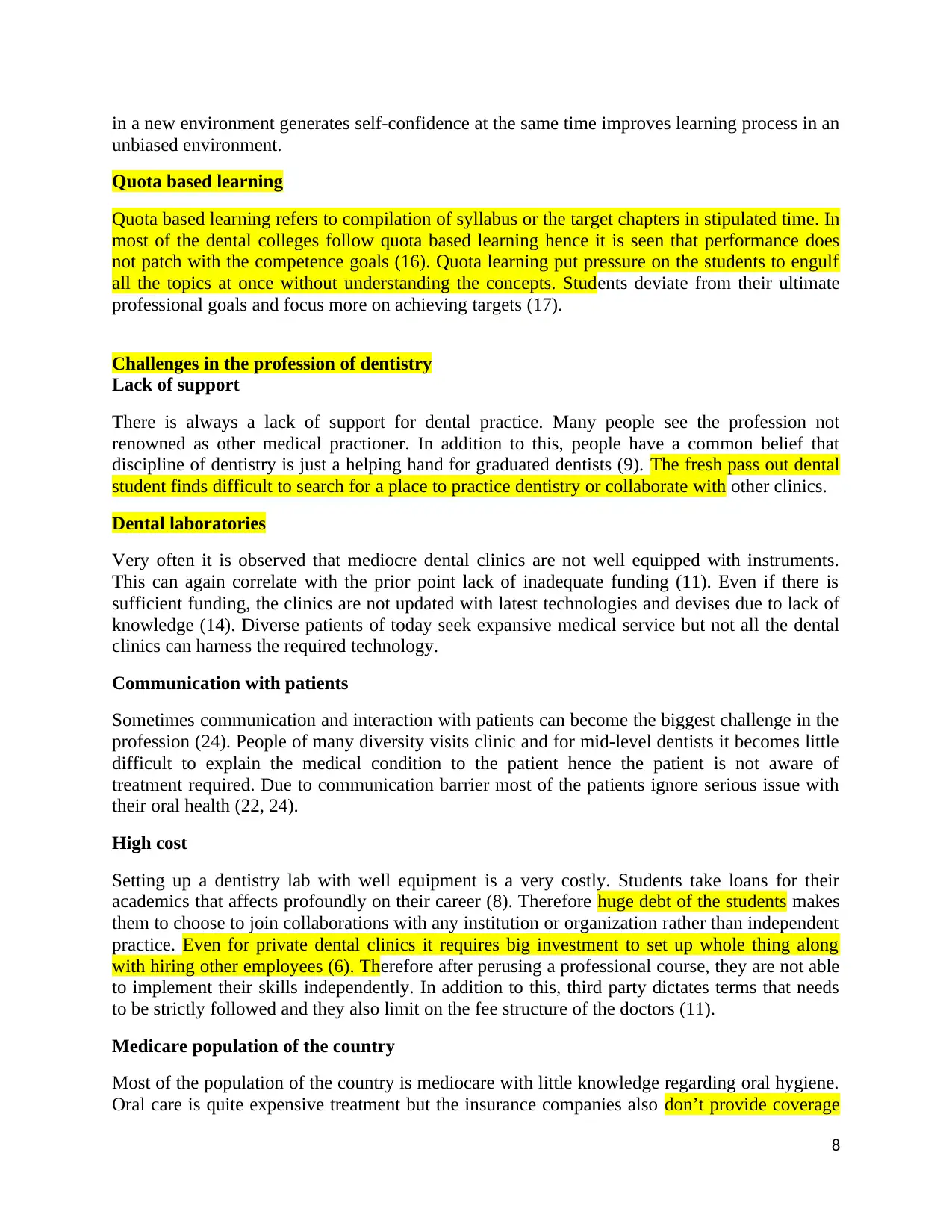
in a new environment generates self-confidence at the same time improves learning process in an
unbiased environment.
Quota based learning
Quota based learning refers to compilation of syllabus or the target chapters in stipulated time. In
most of the dental colleges follow quota based learning hence it is seen that performance does
not patch with the competence goals (16). Quota learning put pressure on the students to engulf
all the topics at once without understanding the concepts. Students deviate from their ultimate
professional goals and focus more on achieving targets (17).
Challenges in the profession of dentistry
Lack of support
There is always a lack of support for dental practice. Many people see the profession not
renowned as other medical practioner. In addition to this, people have a common belief that
discipline of dentistry is just a helping hand for graduated dentists (9). The fresh pass out dental
student finds difficult to search for a place to practice dentistry or collaborate with other clinics.
Dental laboratories
Very often it is observed that mediocre dental clinics are not well equipped with instruments.
This can again correlate with the prior point lack of inadequate funding (11). Even if there is
sufficient funding, the clinics are not updated with latest technologies and devises due to lack of
knowledge (14). Diverse patients of today seek expansive medical service but not all the dental
clinics can harness the required technology.
Communication with patients
Sometimes communication and interaction with patients can become the biggest challenge in the
profession (24). People of many diversity visits clinic and for mid-level dentists it becomes little
difficult to explain the medical condition to the patient hence the patient is not aware of
treatment required. Due to communication barrier most of the patients ignore serious issue with
their oral health (22, 24).
High cost
Setting up a dentistry lab with well equipment is a very costly. Students take loans for their
academics that affects profoundly on their career (8). Therefore huge debt of the students makes
them to choose to join collaborations with any institution or organization rather than independent
practice. Even for private dental clinics it requires big investment to set up whole thing along
with hiring other employees (6). Therefore after perusing a professional course, they are not able
to implement their skills independently. In addition to this, third party dictates terms that needs
to be strictly followed and they also limit on the fee structure of the doctors (11).
Medicare population of the country
Most of the population of the country is mediocare with little knowledge regarding oral hygiene.
Oral care is quite expensive treatment but the insurance companies also don’t provide coverage
8
unbiased environment.
Quota based learning
Quota based learning refers to compilation of syllabus or the target chapters in stipulated time. In
most of the dental colleges follow quota based learning hence it is seen that performance does
not patch with the competence goals (16). Quota learning put pressure on the students to engulf
all the topics at once without understanding the concepts. Students deviate from their ultimate
professional goals and focus more on achieving targets (17).
Challenges in the profession of dentistry
Lack of support
There is always a lack of support for dental practice. Many people see the profession not
renowned as other medical practioner. In addition to this, people have a common belief that
discipline of dentistry is just a helping hand for graduated dentists (9). The fresh pass out dental
student finds difficult to search for a place to practice dentistry or collaborate with other clinics.
Dental laboratories
Very often it is observed that mediocre dental clinics are not well equipped with instruments.
This can again correlate with the prior point lack of inadequate funding (11). Even if there is
sufficient funding, the clinics are not updated with latest technologies and devises due to lack of
knowledge (14). Diverse patients of today seek expansive medical service but not all the dental
clinics can harness the required technology.
Communication with patients
Sometimes communication and interaction with patients can become the biggest challenge in the
profession (24). People of many diversity visits clinic and for mid-level dentists it becomes little
difficult to explain the medical condition to the patient hence the patient is not aware of
treatment required. Due to communication barrier most of the patients ignore serious issue with
their oral health (22, 24).
High cost
Setting up a dentistry lab with well equipment is a very costly. Students take loans for their
academics that affects profoundly on their career (8). Therefore huge debt of the students makes
them to choose to join collaborations with any institution or organization rather than independent
practice. Even for private dental clinics it requires big investment to set up whole thing along
with hiring other employees (6). Therefore after perusing a professional course, they are not able
to implement their skills independently. In addition to this, third party dictates terms that needs
to be strictly followed and they also limit on the fee structure of the doctors (11).
Medicare population of the country
Most of the population of the country is mediocare with little knowledge regarding oral hygiene.
Oral care is quite expensive treatment but the insurance companies also don’t provide coverage
8
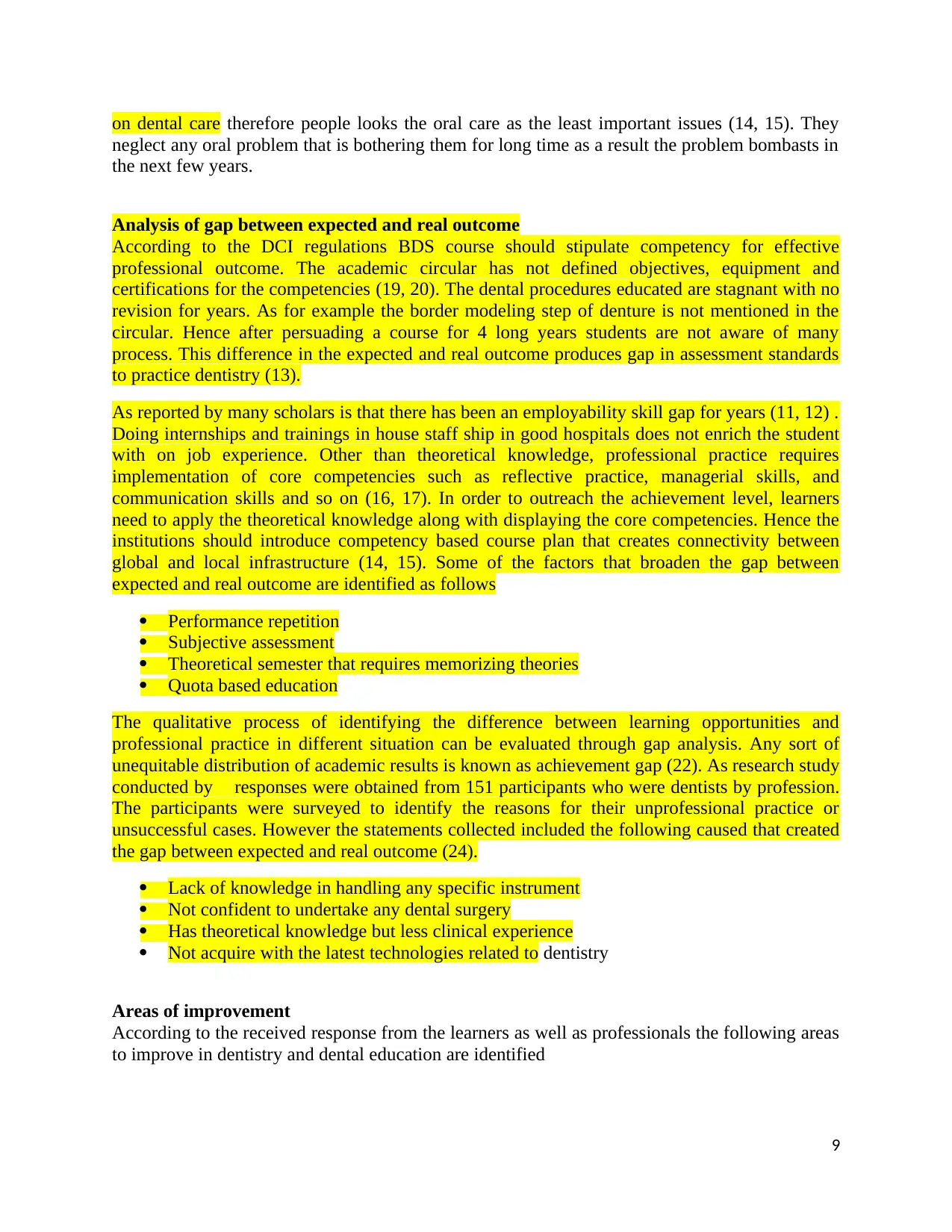
on dental care therefore people looks the oral care as the least important issues (14, 15). They
neglect any oral problem that is bothering them for long time as a result the problem bombasts in
the next few years.
Analysis of gap between expected and real outcome
According to the DCI regulations BDS course should stipulate competency for effective
professional outcome. The academic circular has not defined objectives, equipment and
certifications for the competencies (19, 20). The dental procedures educated are stagnant with no
revision for years. As for example the border modeling step of denture is not mentioned in the
circular. Hence after persuading a course for 4 long years students are not aware of many
process. This difference in the expected and real outcome produces gap in assessment standards
to practice dentistry (13).
As reported by many scholars is that there has been an employability skill gap for years (11, 12) .
Doing internships and trainings in house staff ship in good hospitals does not enrich the student
with on job experience. Other than theoretical knowledge, professional practice requires
implementation of core competencies such as reflective practice, managerial skills, and
communication skills and so on (16, 17). In order to outreach the achievement level, learners
need to apply the theoretical knowledge along with displaying the core competencies. Hence the
institutions should introduce competency based course plan that creates connectivity between
global and local infrastructure (14, 15). Some of the factors that broaden the gap between
expected and real outcome are identified as follows
Performance repetition
Subjective assessment
Theoretical semester that requires memorizing theories
Quota based education
The qualitative process of identifying the difference between learning opportunities and
professional practice in different situation can be evaluated through gap analysis. Any sort of
unequitable distribution of academic results is known as achievement gap (22). As research study
conducted by responses were obtained from 151 participants who were dentists by profession.
The participants were surveyed to identify the reasons for their unprofessional practice or
unsuccessful cases. However the statements collected included the following caused that created
the gap between expected and real outcome (24).
Lack of knowledge in handling any specific instrument
Not confident to undertake any dental surgery
Has theoretical knowledge but less clinical experience
Not acquire with the latest technologies related to dentistry
Areas of improvement
According to the received response from the learners as well as professionals the following areas
to improve in dentistry and dental education are identified
9
neglect any oral problem that is bothering them for long time as a result the problem bombasts in
the next few years.
Analysis of gap between expected and real outcome
According to the DCI regulations BDS course should stipulate competency for effective
professional outcome. The academic circular has not defined objectives, equipment and
certifications for the competencies (19, 20). The dental procedures educated are stagnant with no
revision for years. As for example the border modeling step of denture is not mentioned in the
circular. Hence after persuading a course for 4 long years students are not aware of many
process. This difference in the expected and real outcome produces gap in assessment standards
to practice dentistry (13).
As reported by many scholars is that there has been an employability skill gap for years (11, 12) .
Doing internships and trainings in house staff ship in good hospitals does not enrich the student
with on job experience. Other than theoretical knowledge, professional practice requires
implementation of core competencies such as reflective practice, managerial skills, and
communication skills and so on (16, 17). In order to outreach the achievement level, learners
need to apply the theoretical knowledge along with displaying the core competencies. Hence the
institutions should introduce competency based course plan that creates connectivity between
global and local infrastructure (14, 15). Some of the factors that broaden the gap between
expected and real outcome are identified as follows
Performance repetition
Subjective assessment
Theoretical semester that requires memorizing theories
Quota based education
The qualitative process of identifying the difference between learning opportunities and
professional practice in different situation can be evaluated through gap analysis. Any sort of
unequitable distribution of academic results is known as achievement gap (22). As research study
conducted by responses were obtained from 151 participants who were dentists by profession.
The participants were surveyed to identify the reasons for their unprofessional practice or
unsuccessful cases. However the statements collected included the following caused that created
the gap between expected and real outcome (24).
Lack of knowledge in handling any specific instrument
Not confident to undertake any dental surgery
Has theoretical knowledge but less clinical experience
Not acquire with the latest technologies related to dentistry
Areas of improvement
According to the received response from the learners as well as professionals the following areas
to improve in dentistry and dental education are identified
9
⊘ This is a preview!⊘
Do you want full access?
Subscribe today to unlock all pages.

Trusted by 1+ million students worldwide
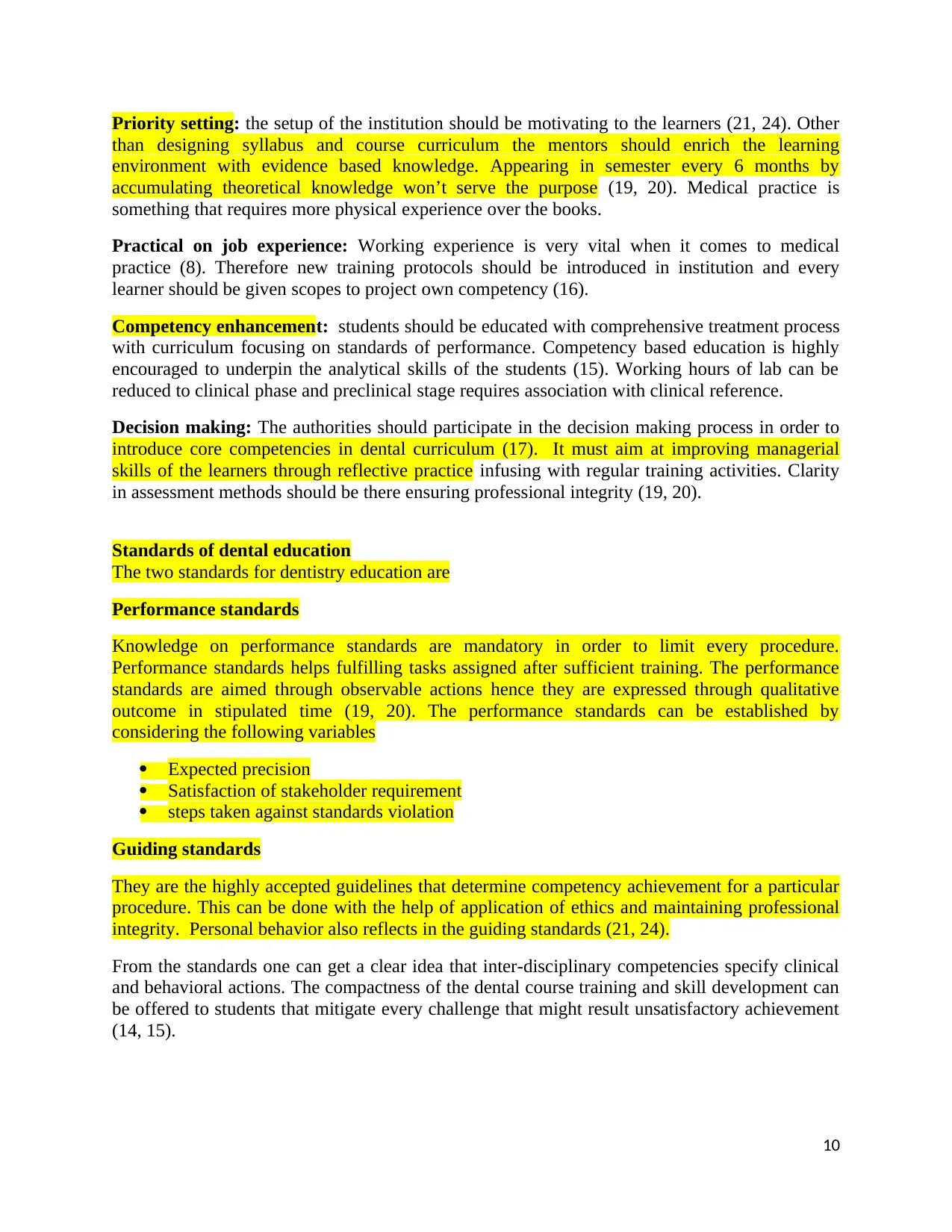
Priority setting: the setup of the institution should be motivating to the learners (21, 24). Other
than designing syllabus and course curriculum the mentors should enrich the learning
environment with evidence based knowledge. Appearing in semester every 6 months by
accumulating theoretical knowledge won’t serve the purpose (19, 20). Medical practice is
something that requires more physical experience over the books.
Practical on job experience: Working experience is very vital when it comes to medical
practice (8). Therefore new training protocols should be introduced in institution and every
learner should be given scopes to project own competency (16).
Competency enhancement: students should be educated with comprehensive treatment process
with curriculum focusing on standards of performance. Competency based education is highly
encouraged to underpin the analytical skills of the students (15). Working hours of lab can be
reduced to clinical phase and preclinical stage requires association with clinical reference.
Decision making: The authorities should participate in the decision making process in order to
introduce core competencies in dental curriculum (17). It must aim at improving managerial
skills of the learners through reflective practice infusing with regular training activities. Clarity
in assessment methods should be there ensuring professional integrity (19, 20).
Standards of dental education
The two standards for dentistry education are
Performance standards
Knowledge on performance standards are mandatory in order to limit every procedure.
Performance standards helps fulfilling tasks assigned after sufficient training. The performance
standards are aimed through observable actions hence they are expressed through qualitative
outcome in stipulated time (19, 20). The performance standards can be established by
considering the following variables
Expected precision
Satisfaction of stakeholder requirement
steps taken against standards violation
Guiding standards
They are the highly accepted guidelines that determine competency achievement for a particular
procedure. This can be done with the help of application of ethics and maintaining professional
integrity. Personal behavior also reflects in the guiding standards (21, 24).
From the standards one can get a clear idea that inter-disciplinary competencies specify clinical
and behavioral actions. The compactness of the dental course training and skill development can
be offered to students that mitigate every challenge that might result unsatisfactory achievement
(14, 15).
10
than designing syllabus and course curriculum the mentors should enrich the learning
environment with evidence based knowledge. Appearing in semester every 6 months by
accumulating theoretical knowledge won’t serve the purpose (19, 20). Medical practice is
something that requires more physical experience over the books.
Practical on job experience: Working experience is very vital when it comes to medical
practice (8). Therefore new training protocols should be introduced in institution and every
learner should be given scopes to project own competency (16).
Competency enhancement: students should be educated with comprehensive treatment process
with curriculum focusing on standards of performance. Competency based education is highly
encouraged to underpin the analytical skills of the students (15). Working hours of lab can be
reduced to clinical phase and preclinical stage requires association with clinical reference.
Decision making: The authorities should participate in the decision making process in order to
introduce core competencies in dental curriculum (17). It must aim at improving managerial
skills of the learners through reflective practice infusing with regular training activities. Clarity
in assessment methods should be there ensuring professional integrity (19, 20).
Standards of dental education
The two standards for dentistry education are
Performance standards
Knowledge on performance standards are mandatory in order to limit every procedure.
Performance standards helps fulfilling tasks assigned after sufficient training. The performance
standards are aimed through observable actions hence they are expressed through qualitative
outcome in stipulated time (19, 20). The performance standards can be established by
considering the following variables
Expected precision
Satisfaction of stakeholder requirement
steps taken against standards violation
Guiding standards
They are the highly accepted guidelines that determine competency achievement for a particular
procedure. This can be done with the help of application of ethics and maintaining professional
integrity. Personal behavior also reflects in the guiding standards (21, 24).
From the standards one can get a clear idea that inter-disciplinary competencies specify clinical
and behavioral actions. The compactness of the dental course training and skill development can
be offered to students that mitigate every challenge that might result unsatisfactory achievement
(14, 15).
10
Paraphrase This Document
Need a fresh take? Get an instant paraphrase of this document with our AI Paraphraser
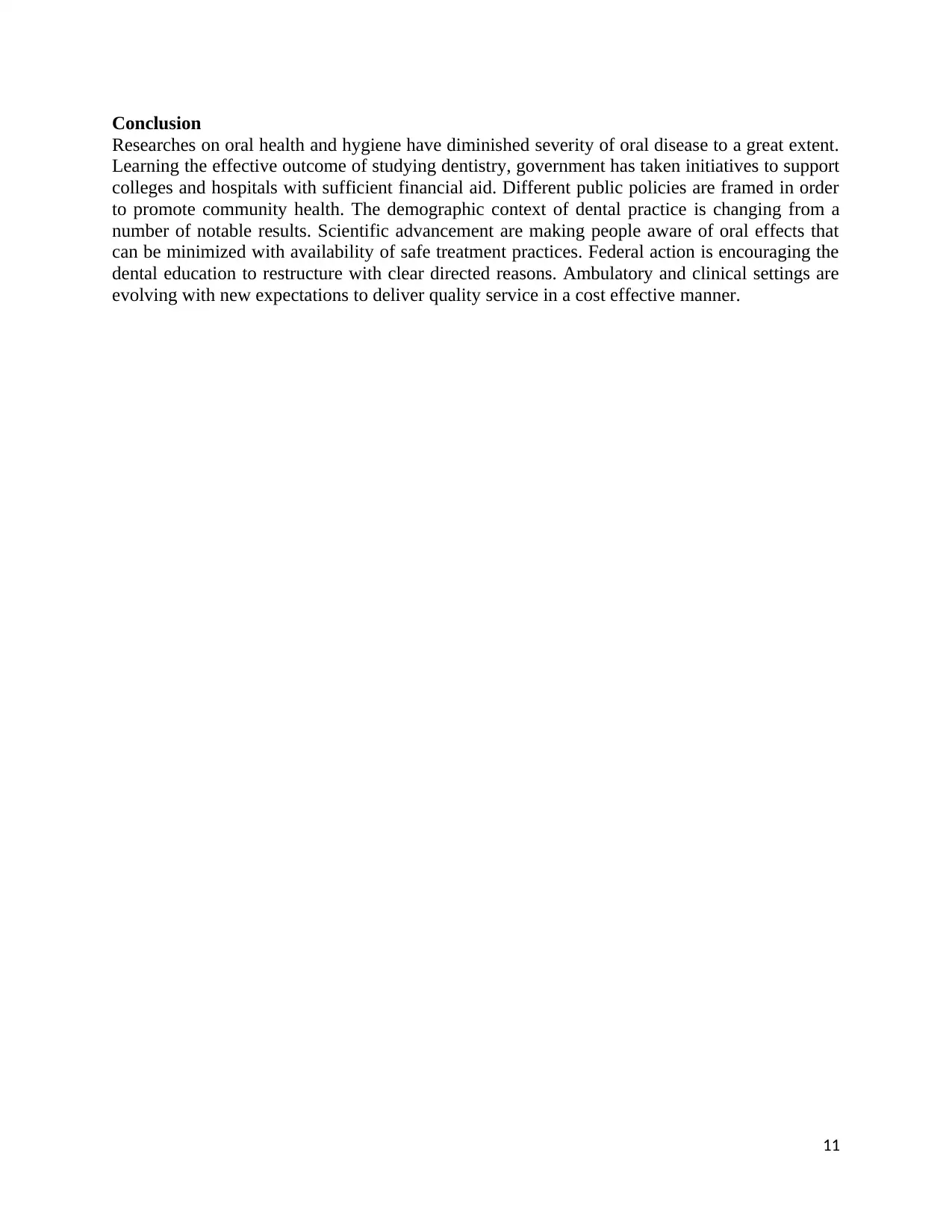
Conclusion
Researches on oral health and hygiene have diminished severity of oral disease to a great extent.
Learning the effective outcome of studying dentistry, government has taken initiatives to support
colleges and hospitals with sufficient financial aid. Different public policies are framed in order
to promote community health. The demographic context of dental practice is changing from a
number of notable results. Scientific advancement are making people aware of oral effects that
can be minimized with availability of safe treatment practices. Federal action is encouraging the
dental education to restructure with clear directed reasons. Ambulatory and clinical settings are
evolving with new expectations to deliver quality service in a cost effective manner.
11
Researches on oral health and hygiene have diminished severity of oral disease to a great extent.
Learning the effective outcome of studying dentistry, government has taken initiatives to support
colleges and hospitals with sufficient financial aid. Different public policies are framed in order
to promote community health. The demographic context of dental practice is changing from a
number of notable results. Scientific advancement are making people aware of oral effects that
can be minimized with availability of safe treatment practices. Federal action is encouraging the
dental education to restructure with clear directed reasons. Ambulatory and clinical settings are
evolving with new expectations to deliver quality service in a cost effective manner.
11
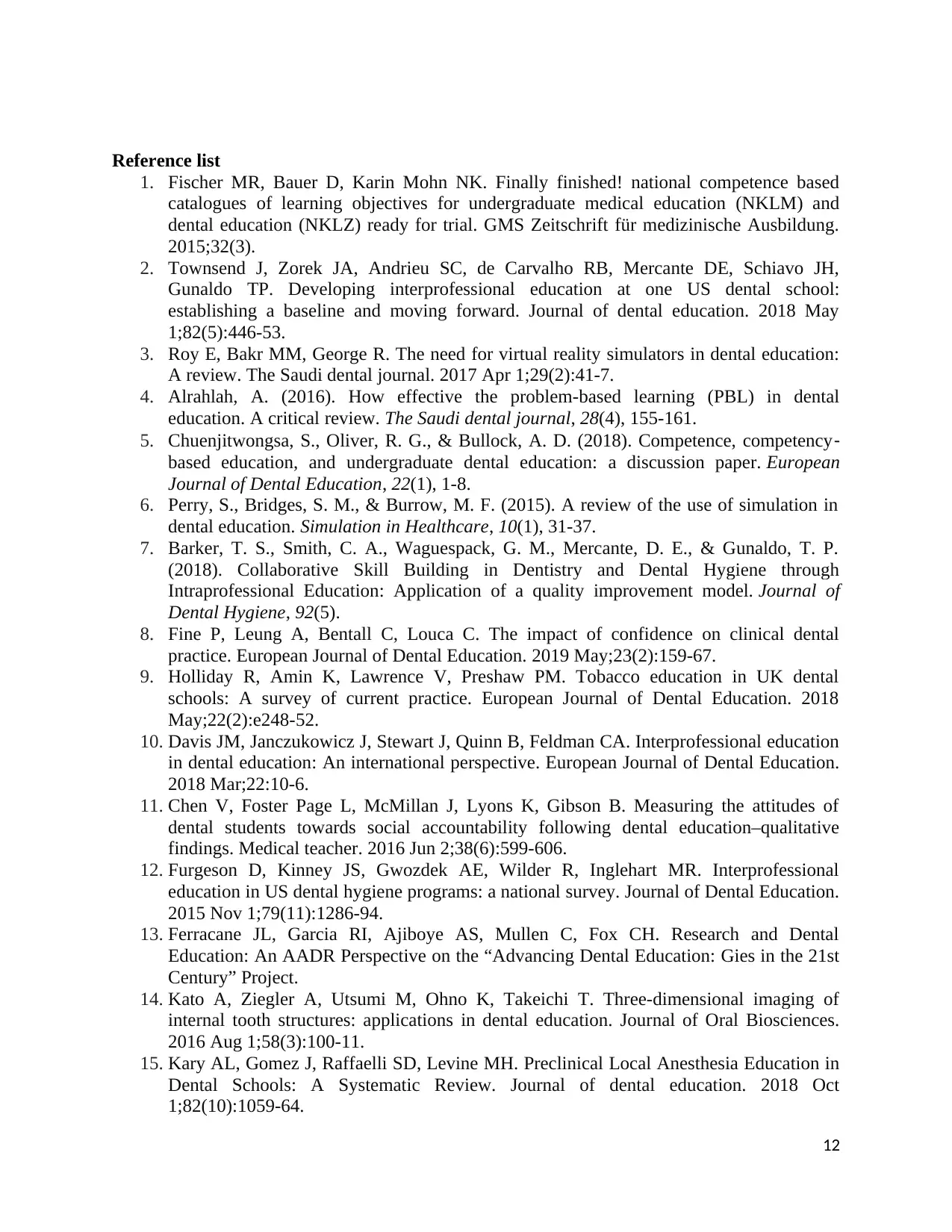
Reference list
1. Fischer MR, Bauer D, Karin Mohn NK. Finally finished! national competence based
catalogues of learning objectives for undergraduate medical education (NKLM) and
dental education (NKLZ) ready for trial. GMS Zeitschrift für medizinische Ausbildung.
2015;32(3).
2. Townsend J, Zorek JA, Andrieu SC, de Carvalho RB, Mercante DE, Schiavo JH,
Gunaldo TP. Developing interprofessional education at one US dental school:
establishing a baseline and moving forward. Journal of dental education. 2018 May
1;82(5):446-53.
3. Roy E, Bakr MM, George R. The need for virtual reality simulators in dental education:
A review. The Saudi dental journal. 2017 Apr 1;29(2):41-7.
4. Alrahlah, A. (2016). How effective the problem-based learning (PBL) in dental
education. A critical review. The Saudi dental journal, 28(4), 155-161.
5. Chuenjitwongsa, S., Oliver, R. G., & Bullock, A. D. (2018). Competence, competency‐
based education, and undergraduate dental education: a discussion paper. European
Journal of Dental Education, 22(1), 1-8.
6. Perry, S., Bridges, S. M., & Burrow, M. F. (2015). A review of the use of simulation in
dental education. Simulation in Healthcare, 10(1), 31-37.
7. Barker, T. S., Smith, C. A., Waguespack, G. M., Mercante, D. E., & Gunaldo, T. P.
(2018). Collaborative Skill Building in Dentistry and Dental Hygiene through
Intraprofessional Education: Application of a quality improvement model. Journal of
Dental Hygiene, 92(5).
8. Fine P, Leung A, Bentall C, Louca C. The impact of confidence on clinical dental
practice. European Journal of Dental Education. 2019 May;23(2):159-67.
9. Holliday R, Amin K, Lawrence V, Preshaw PM. Tobacco education in UK dental
schools: A survey of current practice. European Journal of Dental Education. 2018
May;22(2):e248-52.
10. Davis JM, Janczukowicz J, Stewart J, Quinn B, Feldman CA. Interprofessional education
in dental education: An international perspective. European Journal of Dental Education.
2018 Mar;22:10-6.
11. Chen V, Foster Page L, McMillan J, Lyons K, Gibson B. Measuring the attitudes of
dental students towards social accountability following dental education–qualitative
findings. Medical teacher. 2016 Jun 2;38(6):599-606.
12. Furgeson D, Kinney JS, Gwozdek AE, Wilder R, Inglehart MR. Interprofessional
education in US dental hygiene programs: a national survey. Journal of Dental Education.
2015 Nov 1;79(11):1286-94.
13. Ferracane JL, Garcia RI, Ajiboye AS, Mullen C, Fox CH. Research and Dental
Education: An AADR Perspective on the “Advancing Dental Education: Gies in the 21st
Century” Project.
14. Kato A, Ziegler A, Utsumi M, Ohno K, Takeichi T. Three-dimensional imaging of
internal tooth structures: applications in dental education. Journal of Oral Biosciences.
2016 Aug 1;58(3):100-11.
15. Kary AL, Gomez J, Raffaelli SD, Levine MH. Preclinical Local Anesthesia Education in
Dental Schools: A Systematic Review. Journal of dental education. 2018 Oct
1;82(10):1059-64.
12
1. Fischer MR, Bauer D, Karin Mohn NK. Finally finished! national competence based
catalogues of learning objectives for undergraduate medical education (NKLM) and
dental education (NKLZ) ready for trial. GMS Zeitschrift für medizinische Ausbildung.
2015;32(3).
2. Townsend J, Zorek JA, Andrieu SC, de Carvalho RB, Mercante DE, Schiavo JH,
Gunaldo TP. Developing interprofessional education at one US dental school:
establishing a baseline and moving forward. Journal of dental education. 2018 May
1;82(5):446-53.
3. Roy E, Bakr MM, George R. The need for virtual reality simulators in dental education:
A review. The Saudi dental journal. 2017 Apr 1;29(2):41-7.
4. Alrahlah, A. (2016). How effective the problem-based learning (PBL) in dental
education. A critical review. The Saudi dental journal, 28(4), 155-161.
5. Chuenjitwongsa, S., Oliver, R. G., & Bullock, A. D. (2018). Competence, competency‐
based education, and undergraduate dental education: a discussion paper. European
Journal of Dental Education, 22(1), 1-8.
6. Perry, S., Bridges, S. M., & Burrow, M. F. (2015). A review of the use of simulation in
dental education. Simulation in Healthcare, 10(1), 31-37.
7. Barker, T. S., Smith, C. A., Waguespack, G. M., Mercante, D. E., & Gunaldo, T. P.
(2018). Collaborative Skill Building in Dentistry and Dental Hygiene through
Intraprofessional Education: Application of a quality improvement model. Journal of
Dental Hygiene, 92(5).
8. Fine P, Leung A, Bentall C, Louca C. The impact of confidence on clinical dental
practice. European Journal of Dental Education. 2019 May;23(2):159-67.
9. Holliday R, Amin K, Lawrence V, Preshaw PM. Tobacco education in UK dental
schools: A survey of current practice. European Journal of Dental Education. 2018
May;22(2):e248-52.
10. Davis JM, Janczukowicz J, Stewart J, Quinn B, Feldman CA. Interprofessional education
in dental education: An international perspective. European Journal of Dental Education.
2018 Mar;22:10-6.
11. Chen V, Foster Page L, McMillan J, Lyons K, Gibson B. Measuring the attitudes of
dental students towards social accountability following dental education–qualitative
findings. Medical teacher. 2016 Jun 2;38(6):599-606.
12. Furgeson D, Kinney JS, Gwozdek AE, Wilder R, Inglehart MR. Interprofessional
education in US dental hygiene programs: a national survey. Journal of Dental Education.
2015 Nov 1;79(11):1286-94.
13. Ferracane JL, Garcia RI, Ajiboye AS, Mullen C, Fox CH. Research and Dental
Education: An AADR Perspective on the “Advancing Dental Education: Gies in the 21st
Century” Project.
14. Kato A, Ziegler A, Utsumi M, Ohno K, Takeichi T. Three-dimensional imaging of
internal tooth structures: applications in dental education. Journal of Oral Biosciences.
2016 Aug 1;58(3):100-11.
15. Kary AL, Gomez J, Raffaelli SD, Levine MH. Preclinical Local Anesthesia Education in
Dental Schools: A Systematic Review. Journal of dental education. 2018 Oct
1;82(10):1059-64.
12
⊘ This is a preview!⊘
Do you want full access?
Subscribe today to unlock all pages.

Trusted by 1+ million students worldwide
1 out of 13
Your All-in-One AI-Powered Toolkit for Academic Success.
+13062052269
info@desklib.com
Available 24*7 on WhatsApp / Email
![[object Object]](/_next/static/media/star-bottom.7253800d.svg)
Unlock your academic potential
Copyright © 2020–2025 A2Z Services. All Rights Reserved. Developed and managed by ZUCOL.